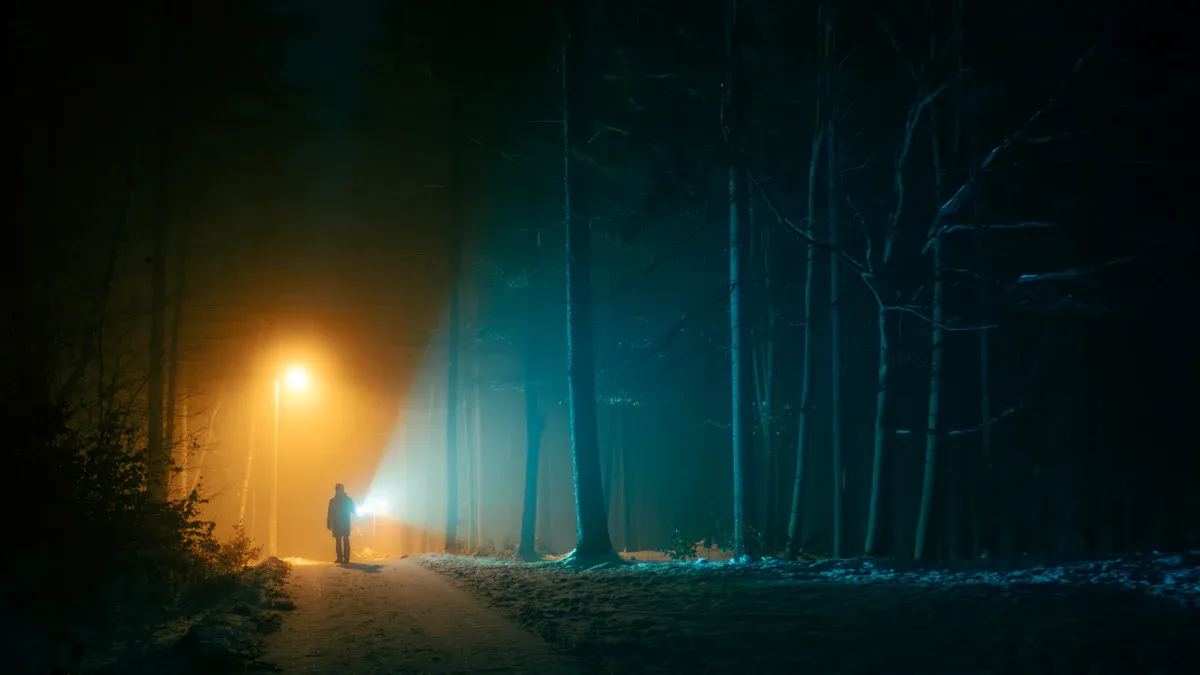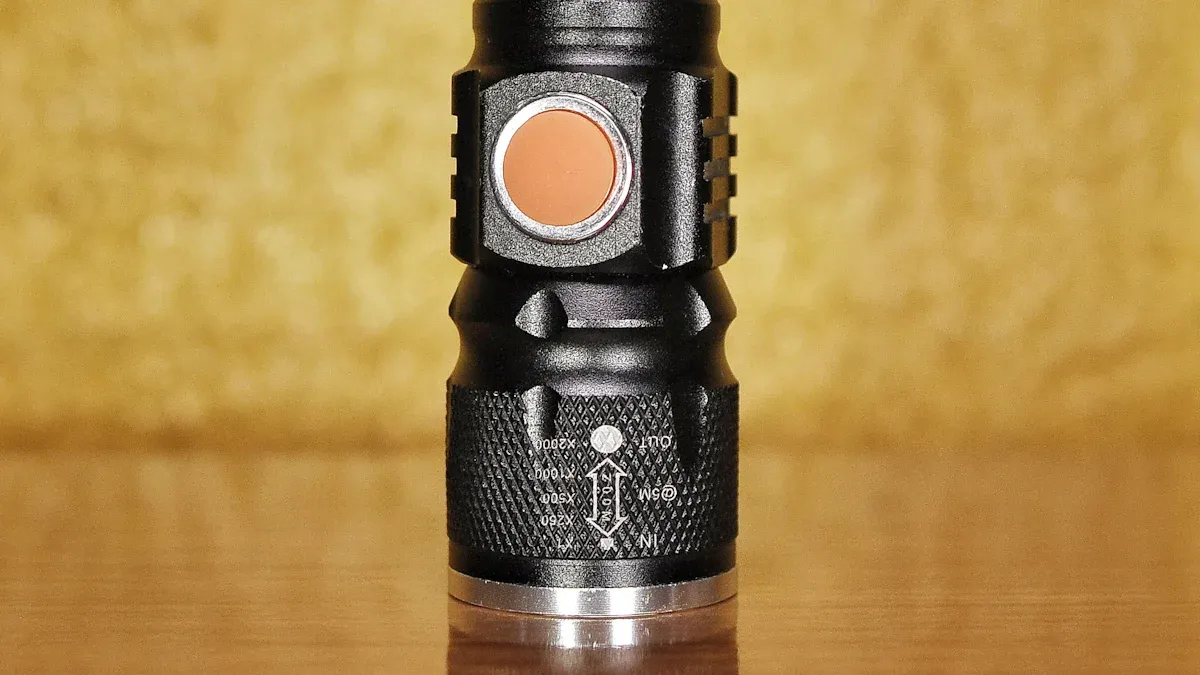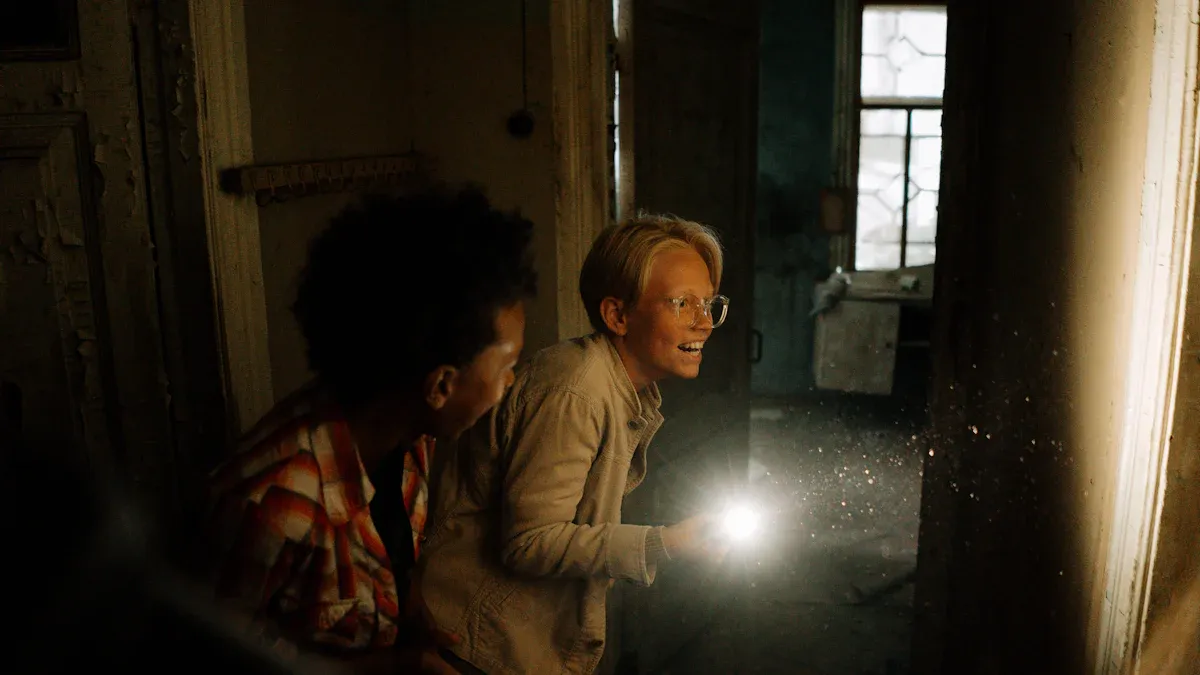Simple Tips to Reduce Flashlight Brightness

Have you ever turned on your flashlight only to feel like you’re staring into the sun? Flashlights today, like the helius flashlight, often pack more brightness than you need for simple tasks. This can strain your eyes or make things harder to see. Finding ways to tone it down can make a big difference.
Key Takeaways
Set your flashlight to low brightness for daily use. This helps your eyes and saves battery power.
Try using diffusers or filters to make the light softer. These make it easier to read or use while camping.
Change the beam focus to cover a bigger space. A wider beam is gentler and better for nearby tasks.
Why Flashlight Brightness Can Be Too High for Daily Tasks
High-lumen flashlights vs. daily needs
Not all flashlights are created equal, and sometimes, they’re just too bright for what you need. High-lumen flashlights, which can range from 1,000 to over 15,000 lumens, are designed for intense activities like search-and-rescue or tactical operations. But for everyday tasks, such as finding your keys or walking your dog at night, this level of brightness can feel overwhelming.
Here’s a quick breakdown of typical lumen ranges and their uses:
Lumen Range | Use Cases |
|---|---|
1-400 | Everyday tasks, leisure activities |
400-1000 | Mechanics, caving, hiking |
1000-3000 | Hunting, tactical use |
3000-7000 | Searching, law enforcement use |
7000-15000 | Outdoor, emergency services |
For most daily needs, sticking to the 1-400 lumen range is more than enough. Anything brighter can make simple tasks unnecessarily complicated.
Situations where excessive brightness is inconvenient
Have you ever tried reading a book or fixing something small with a flashlight that’s too bright? Instead of helping, it creates harsh glare and makes it harder to focus. Excessive brightness can also disturb others, especially in shared spaces like a campsite or a bedroom. Imagine shining a 3,000-lumen flashlight while your family is trying to sleep—it’s not exactly ideal.
In some cases, too much brightness can even reflect off surfaces, temporarily blinding you. This is especially true indoors, where walls and ceilings bounce light back at you. A softer, dimmer light is often the better choice.
Effects of bright light on comfort and visibility
Bright light isn’t always better. When a flashlight is too bright, it can strain your eyes, especially in dark environments. Your pupils adjust to the intense light, making it harder to see anything outside the beam. This can leave you feeling disoriented when you turn the flashlight off.
Additionally, overly bright flashlights can wash out details, making objects appear flat and harder to distinguish. For tasks that require precision, like repairing electronics or reading fine print, a lower brightness level provides better visibility and comfort.
Simple Ways to Reduce Flashlight Brightness

Switching to lower brightness modes
Most modern flashlights come with adjustable beam settings, making it easy to switch to a lower brightness mode. If your flashlight has multiple modes, try cycling through them until you find one that suits your needs. For everyday tasks, like walking in dimly lit areas or searching for something in your bag, lower lumens are often more practical. This not only helps you achieve ideal brightness levels but also extends battery life. If you’re unsure how to adjust the settings, check the user manual or experiment with the buttons. A clean and functional flashlight will make this process smoother.
Using diffusers or filters for softer light
Diffusers and filters are excellent tools for softening a flashlight’s beam. They’re easy to install and portable, making them a great addition to your flashlight maintenance kit. Diffusers spread the light evenly, turning your flashlight into a lantern-like source. This is perfect for camping or creating ambient light. Filters, on the other hand, can preserve night vision, which is especially useful during hunting trips. Both options enhance the functionality of your flashlight without compromising its usability.
Adjusting beam focus for a wider spread
If your flashlight has adjustable beam settings, you can modify the focus to reduce brightness intensity. Widening the beam spreads the light over a larger area, making it less harsh on your eyes. This is particularly helpful indoors or when working on close-up tasks. To adjust the beam, twist the flashlight head or use the focus ring, depending on the model. A wider beam not only softens the light but also improves visibility in tight spaces.
Temporary solutions like tissue or tape as diffusers
Don’t have a diffuser on hand? No problem! You can create a temporary solution using everyday items like tissue paper or clear tape. Simply place a layer of tissue over the flashlight lens or stick a piece of tape across it. This reduces the intensity of the light, giving you a softer glow. While this isn’t a long-term fix, it’s a quick and effective way to manage brightness in a pinch. Just make sure the material doesn’t block the airflow or overheat the flashlight.
Optimizing Helius Flashlights and Headlamps

Adjusting brightness modes on Helius Flashlights
Helius Flashlights are designed with adjustable brightness settings, making them incredibly versatile. You can easily switch between modes to match your needs. Whether you're reading in a dim room or exploring the outdoors, there's a mode for every situation. These settings also help conserve battery life when maximum brightness isn’t necessary. For example, using a lower mode while walking your dog at night can extend the flashlight's runtime significantly.
Tip: Check the user manual to familiarize yourself with the mode-switching process. Most Helius Flashlights use a simple button press to cycle through options.
Using built-in diffusers with Helius Headlamps
Helius Headlamps come with built-in diffusers that soften the light for close-up tasks. These diffusers spread the beam evenly, reducing glare and making it easier on your eyes. If you’re camping or working in tight spaces, this feature is a game-changer. You can activate the diffuser mode with a quick adjustment, transforming your headlamp into a more comfortable light source. It’s perfect for activities like reading maps or setting up a tent in the dark.
Beam focus adjustments for Helius products
Helius Flashlights and Headlamps also allow you to adjust the beam focus. By twisting the flashlight head or using a focus ring, you can switch between a narrow, intense beam and a wider, softer spread. A focused beam works well for spotting objects at a distance, while a wider beam is ideal for illuminating larger areas. This flexibility makes Helius products some of the best tools for various tasks, from hiking to home repairs.
Recommended settings for common tasks
Here’s a quick guide to help you choose the best settings for your Helius Flashlight or Headlamp:
Task | Recommended Mode | Beam Focus | Notes |
|---|---|---|---|
Reading | Low | Wide | Use the diffuser for softer light |
Walking at night | Medium | Wide | Conserves battery life |
Outdoor exploration | High | Narrow | Ideal for spotting distant objects |
Emergency situations | Strobe/SOS | Narrow or Wide | Attracts attention quickly |
By selecting the right mode and beam focus, you can make the most of your Helius Flashlight. It’s all about matching the settings to your activity for optimal performance.
Additional Considerations for Flashlight Use
Battery life impact of lower brightness
Using your flashlight on lower brightness settings can significantly extend its runtime. Lower brightness consumes less power, which means your flashlight will last longer before needing a recharge or battery replacement. This is especially useful if you rely on your flashlight for tasks that require long battery life, like camping or emergency situations.
Here’s why reducing brightness helps:
Lower power consumption means the flashlight draws less energy from the battery.
High-quality batteries maintain consistent brightness over time, even at lower settings.
Compact flashlights with rechargeable batteries benefit the most, as they’re designed for efficiency and portability.
If you’re using a flashlight with adjustable features, switching to a dimmer mode can also improve its durability. This ensures your flashlight remains reliable when you need it most, whether for hands-free tasks or emergency rescue operations.
Tip: Always carry spare batteries or a portable charger to maximize your flashlight’s runtime during extended use.
Safety tips for reduced brightness settings
While dimming your flashlight can be helpful, it’s important to use it safely. Reduced brightness may limit visibility in certain situations, so you’ll want to adjust accordingly. For example, when walking in poorly lit areas, ensure the beam is bright enough to spot obstacles.
Here are a few safety tips to keep in mind:
Use hands-free options like headlamps for better control in low-light conditions.
Avoid using extremely low brightness in areas with potential hazards, like uneven terrain.
Test your flashlight’s features beforehand to ensure you’re familiar with its settings.
By balancing brightness and safety, you can enjoy the flashlight’s portability and durability without compromising visibility.
When to switch back to higher brightness levels
Sometimes, you’ll need to crank up the brightness for safety or efficiency. Outdoor environments with strong lighting, like direct sunlight, often require higher brightness to maintain visibility. This is especially true when reading maps or navigating unfamiliar terrain.
In critical situations, such as emergency rescue operations, higher brightness ensures you can see clearly and respond quickly. Flashlights with adjustable features make it easy to switch modes, so you’re always prepared. Whether you’re signaling for help or inspecting distant objects, a brighter beam can be a lifesaver.
Note: Always check your flashlight’s runtime when using higher brightness levels. This helps you plan ahead and avoid running out of power during crucial moments.
Reducing flashlight brightness doesn’t have to be complicated. You can switch to lower modes, use diffusers, or even try quick fixes like tissue paper. These simple adjustments make your flashlight more comfortable and practical for everyday use.
Helius Flashlights and Headlamps adapt to your needs effortlessly:
Adjustable light modes let you choose between focused or wide beams.
Hands-free operation keeps your tasks efficient and hassle-free.
Customizable brightness levels suit everything from outdoor adventures to daily chores.
For emergencies, these tools shine even brighter:
Search and rescue operations become safer with improved visibility.
Hands-free lighting ensures you can work efficiently in critical situations.
Reliable beams enhance teamwork and communication during crises.
Try these tips and explore how Helius products can simplify your life. You’ll love the versatility they bring to every situation!
FAQ
How do I choose the right flashlight for hiking or camping?
Look for a lightweight flashlight with adjustable brightness, water resistance, and long battery life. These features ensure reliability while navigating in low-light conditions outdoors.
Can I use a flashlight with hands-free usability for hiking?
Yes! Headlamps are perfect for hiking. They’re lightweight, offer hands-free usability, and provide excellent illumination for tasks like setting up tents or exploring trails.
Why is water resistance important for outdoor tasks?
Water resistance protects your flashlight during unexpected rain or wet conditions. It ensures durability and reliability, especially when hiking or camping in unpredictable weather.
See Also
Maximize Your Flashlight's Battery Life With These Tips
Key Maintenance Tips To Keep Your Flashlight Functional
A Complete Guide To Understanding Flashlight Brightness Levels
